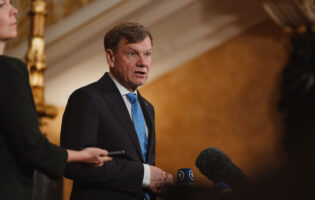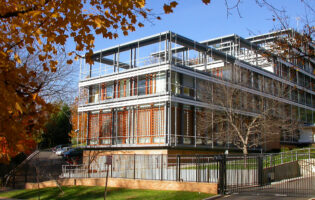
Vincent Eisfeld via Wikimedia Commons
Elections in Thuringia: Can Ramelow’s Coalition Hold On?

Ben Friedman
Ben Friedman was a research intern at AICGS for the summer of 2019. He conducts research for current projects and for resident fellows, helps organize and document events, manages the database, and operates the front desk at AICGS.
Mr. Friedman is a junior at the University of Colorado Boulder, where he is pursuing a double major in German and International Affairs. His research and academic interests include security and defense issues, Russia, populism, and political extremism in Europe and the United States.
Previously, Mr. Friedman has interned as an assistant German teacher at the high school level. He is preparing to study abroad for a full academic year at the University of Regensburg in Germany.
On October 27, voters in the eastern German state of Thuringia will head to the polls. In Thuringia’s last election, which took place in 2014, a left-wing “red-red-green” coalition was formed between the Linke, the Social Democrats (SPD), and the Greens, claiming the majority over the traditional CDU leadership. This year it will be determined whether that coalition will continue, as the current polls show the coalition short of a majority. One threat to the continuation of “red-red-green” is the surge in support for the Alternative for Germany (AfD), which has grown immensely not only in Thuringia but all over Germany. In 2014 the AfD burst on to the scene and claimed its first seats in Thuringia’s parliament. The right-wing party’s hopes of securing a coalition are slim to none, as all other parties refuse to work with them. Yet their growth is worrying for many.
Despite comparatively high levels of support for the Linke and the AfD elsewhere, the Christian Democratic Union (CDU) reigned supreme in Thuringia from reunification until the last state elections in 2014.
Thuringia’s East German history unsurprisingly plays a large role in its politics. Mirroring its East German neighbors, Thuringia is a relatively poor state, a factor that tends to produce strong support for protest parties such as the Linke and the AfD. Yet despite comparatively high levels of support for the Linke and the AfD elsewhere, the Christian Democratic Union (CDU) reigned supreme in Thuringia from reunification until the last state elections in 2014, when it failed to form a coalition. Instead, a left-leaning “red-red-green” coalition consisting of the SPD, the Greens, and the Linke was formed. This coalition elected the Linke’s Bodo Ramelow as minister-president, marking the first socialist-led government in Germany since reunification.
The recent success of the Linke has links to Thuringia’s past, as many perceived the 2014 elections as empowering the same communist politics of the German Democratic Republic. As a party on the left, the Linke is often associated with the SED politics of former East Germany. Many came out in protest, yelling “Stasi out” and claiming that “perpetrators” were headed back in to office. The Linke’s growth in the state has only increased since then, and it is currently polling in first place at 25 percent. The party emphasizes the importance of social justice and human rights, similarly to the SPD. Bodo Ramelow hopes to continue leading his left-wing coalition following the election this October. In the most recent polls he is leading as the clear favorite in the minister-president race, ahead of the CDU’s Mike Mohring.
Just behind the Linke is the AfD. The AfD in Thuringia, led by the especially controversial Björn Höcke, garners high levels of support—as it does throughout eastern Germany. It is currently polling at 24 percent, just shy of the Linke. The AfD’s hopes of a coalition are remote, however, as no other party in Thuringia has expressed any desire to work with the far-right group. AfD “Spitzenkandidat” Höcke was made infamous when he denounced German remembrance efforts of its Nazi past. In reaction to Höcke’s statements on these remembrance efforts, a replica of the Berlin Holocaust Memorial was built next to his house.
The AfD’s hopes of a coalition are remote, however, as no other party in Thuringia has expressed any desire to work with the far-right group.
Also doing historically well in Thuringia is the Green Party. Currently polling at 11 percent as of now, it sits behind the CDU and in front of the SPD. The Greens have seen a surge not only in Thuringia, but all over Germany. Focusing their campaign on the environment and climate change politics, they are led by candidates Anja Siegesmund and Dirk Adams. Like the SPD and the Linke, the Greens hope to hold on to the elusive “red-red-green” coalition.
In front of the Greens in the polls at 21 percent are the CDU, the one-time center-right stalwart of Thuringia. Led by Mike Mohring, they are focused on issues such as economics, education, and security. Despite its long history in power in the state, the CDU is in danger of falling even more. Voters have slowly drifted away from Christian Democrats in the East. The AfD has tapped into voter frustration in order to gain a larger following, and the Greens have drawn younger and more urban support. The politically centrist CDU has found itself losing followers who migrate left or right of center.
Another headline of the Thuringia elections is the trouble facing the SPD. The SPD has been in decline not only in Thuringia, but across Germany. The 155-year-old party has been collapsing in western German states, as well as in the east. Wolfgang Tiefensee, the SPD’s candidate and party leader in Thuringia, wants to hold on to the previous coalition with the Linke and the Greens. He hopes that the party will be the “Partei des Ausgleichs,” or the party of balancing. Points of focus for the party include education and worker’s rights. In terms of climate change, Tiefensee views it as an important issue yet hopes to strike a middle ground. The downfall of Thuringia’s SPD is one factor putting the survival of the “red-red-green” coalition in danger.
The latest polls show that forming a coalition will be no easy task. The Linke, the Greens, and the SPD are sitting at 46 percent, or 41 out of 88 seats. This is not enough for a majority coalition. A majority could be achieved with support from the CDU or the AfD, but the CDU has declined this option and no parties on the left are willing to work with the AfD.
A four-part CDU, SPD, Green, and Free Democratic (FDP) coalition is also a slight possibility, but this would depend on whether the tiny FDP can even overcome the 5 percent hurdle to entry to the Landtag. Faced with a rising AfD and Linke, and the decline of the CDU and SPD, finding a coalition will be a daunting task. Despite these challenges, those on the left hope to retain their “red-red-green” coalition this October.








